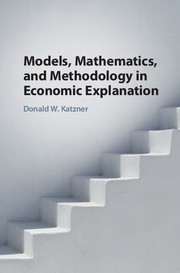Book contents
- Frontmatter
- Dedication
- Contents
- Preface
- Introduction
- 1 Science and Economics
- 2 Economic Models and Explanation
- 3 The Stages of Model Building in Economics
- 4 Models and Mathematics
- 5 Models and Measurement (or Lack Thereof)
- 6 Issues Relating to the Construction of Models from Scratch
- 7 An Example: The Efficiency of Organizational Forms
- 8 The Implicit Assumption Requirements of Later-Stage Model Building
- 9 Ordinality and the Adequacy of Analytic Specification
- 10 Categories of Models
- 11 Conclusion
- Index
6 - Issues Relating to the Construction of Models from Scratch
Published online by Cambridge University Press: 26 October 2017
- Frontmatter
- Dedication
- Contents
- Preface
- Introduction
- 1 Science and Economics
- 2 Economic Models and Explanation
- 3 The Stages of Model Building in Economics
- 4 Models and Mathematics
- 5 Models and Measurement (or Lack Thereof)
- 6 Issues Relating to the Construction of Models from Scratch
- 7 An Example: The Efficiency of Organizational Forms
- 8 The Implicit Assumption Requirements of Later-Stage Model Building
- 9 Ordinality and the Adequacy of Analytic Specification
- 10 Categories of Models
- 11 Conclusion
- Index
Summary
In this and the following chapter, the threads of preceding discussion will be brought together to throw light on the actual construction of an explanatory model. Recall that in Chapters 2 and 3 model construction was conceived of in terms of five successive steps or stages: (i) formulate an initial image of the subject of inquiry; (ii) develop a preliminary model based on that image; (iii) operationalize the model; (iv) empirically test the model when appropriate; and (v) judge the model's cogency and relevance. Although model building can begin at stage (iii) as long as the first two stages have already been completed in some other venue, the present chapter considers in greater detail the process of construction that is associated with the first two stages. This will often involve the extraction of variables and relations among them from the amorphous reality of the observed phenomenon under investigation. That extraction requires considerations relating to the manner of abstraction that are both subtle and fundamental to the outcome of the inquiry. Chapter 7 will provide a concrete illustration of the full construction process.
To see what is involved, consider the distinction between arithmomorphic and dialectical concepts due to Georgescu-Roegen [4, pp. 43–47]. First, in certain cases, the human mind is perfectly capable of sharply delineating the boundaries of an idea. The result is an arithmomorphic concept. Such concepts, regardless of whether or not they are quantified, have the property that they can be clearly distinguished and separated from all others. They are distinctly discrete and there is no overlap between them and their opposites. The velocity of a moving object is an arithmomorphic concept as is the weight of a pot of water and the length of a train. When measures are not available, non-quantifiable ideas such as the notion of a human being or a country, also have expressions in arithmomorphic form. An arithmomorphic representation of the former is so-called economic man.
On the other hand, there are concepts whose boundaries human powers seem unable to clearly and precisely define. Exact characterizations are either arbitrary in that they do not conform to standard notions or are extraordinarily difficult to employ.Where, for example, does one quality of experience leave off and another begin?
Information
- Type
- Chapter
- Information
- Models, Mathematics, and Methodology in Economic Explanation , pp. 125 - 143Publisher: Cambridge University PressPrint publication year: 2017
